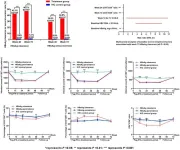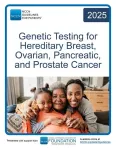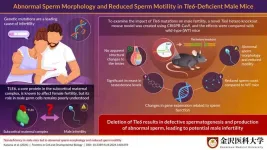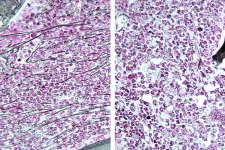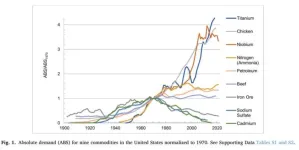(Press-News.org) Wearable devices can identify, differentiate, and predict flare-ups, or the worsening of symptoms and inflammation, in inflammatory bowel disease (IBD), Mount Sinai researchers have shown in a first-of-its-kind study.
The findings, published in the journal Gastroenterology on January 16, suggest that wearable technology can predict the subsequent development of flares in IBD, enabling continuous disease monitoring through widely available commercial devices.
“Current disease-monitoring methods rely on patients directly interacting with their doctors, either through office visits, blood or stool testing, or by undergoing a colonoscopy. These methods also only assess the disease at one point in time, and can often be invasive or inconvenient,” said first author Robert Hirten, MD, Clinical Director of the Hasso Plattner Institute for Digital Health; and Associate Professor of Medicine (Gastroenterology), and Artificial Intelligence and Human Health, at the Icahn School of Medicine at Mount Sinai. “Our study shows that commonly used wearable devices such as Apple Watches, Fitbits, and Oura Rings can be effective tools in monitoring chronic inflammatory diseases like IBD. This creates an opportunity to monitor the disease remotely outside the health care setting, in a continuous manner, and potentially in real time.”
IBD is a chronic condition that causes inflammation in the intestines and affects more than 2.4 million people in the United States. Mount Sinai researchers enrolled more than 300 participants with ulcerative colitis or Crohn’s disease, the two major types of IBD, from 36 states. The participants wore devices, answered daily symptom surveys, and provided blood and stool assessments of inflammation.
The researchers found that circadian patterns of heart rate variability (a marker of nervous system function), along with heart rate, oxygenation, and daily activity, all measured by the wearable devices, were significantly altered when inflammation or symptoms were present. Moreover, these physiological markers could detect inflammation even in the absence of symptoms and distinguish whether symptoms were driven by active inflammation in the intestines. Importantly, the researchers found that these metrics measured by wearables changed up to seven weeks before flares developed.
The researchers are applying similar approaches to other chronic inflammatory diseases, such as rheumatoid arthritis, and leveraging artificial intelligence to develop algorithms using wearable device data to predict flares on an individualized basis. “These findings open the door to leveraging wearable technology for health monitoring and disease management in innovative ways we haven’t previously considered,” Dr. Hirten said. “Our hope is that, in the future, this approach will significantly enhance the quality of life of our patients.”
About the Mount Sinai Health System
Mount Sinai Health System is one of the largest academic medical systems in the New York metro area, with 48,000 employees working across eight hospitals, more than 400 outpatient practices, more than 600 research and clinical labs, a school of nursing, and a leading school of medicine and graduate education. Mount Sinai advances health for all people, everywhere, by taking on the most complex health care challenges of our time—discovering and applying new scientific learning and knowledge; developing safer, more effective treatments; educating the next generation of medical leaders and innovators; and supporting local communities by delivering high-quality care to all who need it.
Through the integration of its hospitals, labs, and schools, Mount Sinai offers comprehensive health care solutions from birth through geriatrics, leveraging innovative approaches such as artificial intelligence and informatics while keeping patients’ medical and emotional needs at the center of all treatment. The Health System includes approximately 9,000 primary and specialty care physicians and 11 free-standing joint-venture centers throughout the five boroughs of New York City, Westchester, Long Island, and Florida. Hospitals within the System are consistently ranked by Newsweek’s® “The World’s Best Smart Hospitals, Best in State Hospitals, World Best Hospitals and Best Specialty Hospitals” and by U.S. News & World Report’s® “Best Hospitals” and “Best Children’s Hospitals.” The Mount Sinai Hospital is on the U.S. News & World Report® “Best Hospitals” Honor Roll for 2024-2025.
For more information, visit https://www.mountsinai.org or find Mount Sinai on Facebook, Twitter and YouTube.
END
Mount Sinai study finds wearable devices can detect and predict inflammatory bowel disease flare-ups
2025-01-16
ELSE PRESS RELEASES FROM THIS DATE:
Peripheral blood CD4+/CD8+ t cell ratio predicts HBsAg clearance in inactive HBsAg carriers treated with peginterferon alpha
2025-01-16
Background and Aims
T lymphocytes play a pivotal role in resolving hepatitis B virus infection. This study aimed to investigate the dynamics of peripheral blood T lymphocyte subsets during peginterferon alpha (peg-IFN-α) therapy and their association with hepatitis B surface antigen (HBsAg) clearance in inactive HBsAg carriers (IHCs).
Methods
This prospective observational study enrolled 197 IHCs treated with peg-IFNα-2a/2b for 48 weeks and followed for 24 weeks (treatment group), and 221 IHCs who were regularly monitored for 72 weeks without treatment (IHC control group). ...
MIT Press’s Direct to Open reaches annual funding goal for 2025, opens access to 80 new monographs
2025-01-16
January 16, 2024 - The MIT Press is pleased to announce that Direct to Open (D2O) has reached its full funding goal for 2025 and will open access to 80 new monographs and edited book collections in the spring and fall publishing seasons.
“It has been one of the greatest privileges of my career to contribute to this program and demonstrate that our academic community can unite to publish high-quality open access monographs at scale,” said Amy Harris, Senior Manager of Library Relations ...
New NCCN patient resource shares latest understanding of genetic testing to guide patient decision making
2025-01-16
PLYMOUTH MEETING, PA [January 16, 2025] — Today, the National Comprehensive Cancer Network® (NCCN®)—an alliance of leading cancer centers—published a new resource to inform people about the latest recommendations around hereditary and familial cancer risk. This essential guide is based on the latest evidence and expert consensus in the rapidly advancing field of cancer genetics. It provides guidance on how best to assess, and test for, inherited genetic mutations that can raise the ...
Synchronization in neural nets: Mathematical insight into neuron readout drives significant improvements in prediction accuracy
2025-01-16
Reservoir computing (RC) is a powerful machine learning module designed to handle tasks involving time-based or sequential data, like tracking patterns over time or analyzing sequences. It is widely used in areas such as finance, robotics, speech recognition, weather forecasting, natural language processing, and predicting complex nonlinear dynamical systems. What sets RC apart is its efficiency—it delivers powerful results with much lower training costs compared to other methods.
RC uses a fixed, randomly connected network layer, known as the reservoir, to turn input data into a more complex representation. ...
TLE6 identified as a protein associated with infertility in male mice
2025-01-16
Infertility is a major global challenge associated with physiological and psychological impact. Genetic mutations that affect early embryonic development, oocyte (egg cell) maturation, and fertilization have recently been studied as causes of infertility. One of the most well-studied causes of early embryonic infertility is mutations in the subcortical maternal complex (SCMC)-related genes.
SCMC participates in embryo development and cleavage by maintaining the structure of the egg cytoplasm and recruiting proteins that assist proper embryo formation. SCMC is composed of multiple proteins, of which the transducin-like ...
Thin lenses have a bright future
2025-01-16
Paper-thin optical lenses simple enough to mass produce like microchips could enable a new generation of compact optical devices. A team with researchers at the University of Tokyo and JSR Corp. fabricated and tested flat lenses called Fresnel zone plates (FZPs), but did so for the first time using only common semiconductor manufacturing equipment, the i-line stepper, for the first time. These flat lenses currently lack the efficiency of in-production lenses, but have the potential to reshape optics for industries ranging from astronomy to health care and consumer electronics.
Flat lenses, such as metalenses, exist, but they come with hefty price tags ...
Volcanic eruption caused Neolithic people to sacrifice unique "sun stones"
2025-01-16
Throughout history, volcanic eruptions have had serious consequences for human societies such as cold weather, lack of sun, and low crop yields. In the year 43 BC when a volcano in Alaska spewed large quantities of sulphur into the stratosphere, harvests failed the following years in the countries around the Mediterranean, causing famine and disease. This is well-documented in written sources from ancient Greece and Rome.
We do not have written sources from the Neolithic. But climate scientists from the Niels Bohr Institute at the University of Copenhagen have analysed ice cores from the Greenland ice sheet and can now document that around 2,900 ...
Drug in clinical trials for breast cancer could also treat some blood cancers
2025-01-16
Two new studies led by researchers at Washington University School of Medicine in St. Louis have identified a possible way to block the progression of several forms of blood cancer using a drug already in clinical trials against breast cancer.
The studies — both conducted in patient samples and animal models — found that inhibiting a protein called RSK1 reduces inflammation and stops the progression of blood cancers called myeloproliferative neoplasms (MPNs) as well as an aggressive form of acute myeloid leukemia (AML). With the RSK1 inhibitor already in clinical testing, the path to expanded use as a treatment for blood ...
Study identifies mechanism underlying increased osteoarthritis risk in postmenopausal females
2025-01-16
Osteoarthritis (OA) is a condition that disproportionally affects postmenopausal women, and the millions affected can attest to the pain, reduced mobility and diminished quality of life that comes from this disease. While the hormonal changes associated with menopause have long been known to accelerate the development and progression of OA, a deeper understanding of the biological mechanisms that underlie this correlation is crucial for developing effective treatments.
A new study led by researchers at Spaulding Rehabilitation, a member of the Mass General Brigham ...
The material revolution: How USA’s commodity appetite evolved from 1900 to present
2025-01-16
A new study documents the dramatic change in America’s material diet from 1900 to 2020 – ongoing shifts in US commodity consumption patterns with profound environmental, economic, and geopolitical implications.
Published by Iddo K. Wernick of The Rockefeller University’s Program for the Human Environment in the Elsevier journal Resources Policy, the paper details the consumption of 100 key commodities used to build cities, power cars, produce everyday products, and connect people. It charts transformative changes since the start of the 20th century in both absolute ...
